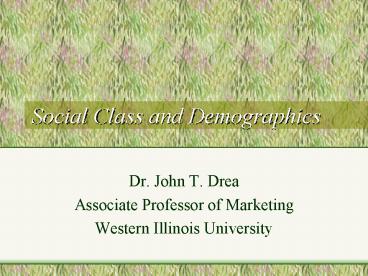Social Class and Demographics - PowerPoint PPT Presentation
1 / 12
Title:
Social Class and Demographics
Description:
Emphasis is to 'do the right thing' and buy 'what's popular. ... Admires/emulates upper class. Deferred gratification is an ideal but may not be practiced. ... – PowerPoint PPT presentation
Number of Views:37
Avg rating:3.0/5.0
Title: Social Class and Demographics
1
Social Class and Demographics
- Dr. John T. Drea
- Associate Professor of Marketing
- Western Illinois University
2
Characteristics of an Effective Social Class
System
- Rank ordering
- Relative permanence
- Intergenerational class mobility
- Internal homogeneity
- Distinct from income
3
Social Status in America
- Upper Americans (14)
- common goals, differentiated mainly by income
- quality merchandise is most prized.
- self-expression is prized.
- High consumption priorities include theater,
books, European travel, household help, club
memberships and prestige schooling for children
4
Social Status in America (continued)
- Middle Americans (70)
- Middle Class (32)
- Emphasis is to do the right thing and buy
whats popular. - Increased earnings mean better neighborhoods with
good schools. - Spends money on worthwhile experiences for
children. - Home appearance is important.
- Admires/emulates upper class.
- Deferred gratification is an ideal but may not be
practiced.
5
Social Class in America (continued)
- Middle Class (70) continued
- Working Class (38)
- These are family folk - they depend heavily on
relatives for economic and emotional support. - More limited horizons comparisons are made to
other relatives and peers. - Group characteristics change little even when
incomes rise. - Discretionary spending focuses on ease of labor
and leisure purchases
6
Social Status in America (continued)
- Lower Americans
- Highly heterogeneous behaviors.
- Behaviors range greatly from an intense focus on
immediate gratification to strong religious
beliefs and delayed gratification (not earthly)
7
Measuring Social Status
- Single item vs. multi-item
- Single item measures do not accurately reflect
social status, since there is variation of
perceived status according to factors other than
the one measured
Individually, single item measures fail to
adequately assess a construct in its entirety.
8
Measuring Social Status
- Multi-item measures
- Hollingshead Index of Social Position
- Widely used
- Two factors occupation and education
- Warners Index of Status Characteristics
- Also widely used
- Four factorsoccupation, source of income, house
type, dwelling
9
Measuring Social Status
- Socioeconomic Status Scale
- US Dept of the Census
- Three factors occupation, income, and education
- Computerized Status Index
- Coleman (1983)
- Four factors education, occupational prestige,
area of residence, and family income
10
Social Status vs. Income
- Social status is more relevant than income when
- purchases do not involve high dollar expenditures
but do reflect underlying differences in
lifestyle, values, or roles not captured by
income - Social status is also superior for the purchase
of highly visible, symbolic, and expensive items.
11
Social Class vs. Income (continued)
- Income is more appropriate than social class
when - products require substantial expenditures but are
not status symbols within the social class. - washers, dryers, kitchen appliances
12
Demographic Data
- Demographics describe a population by its
- size of individuals in a population
- distribution location of individuals
- structure descriptors of the population in terms
of age, income, education, and occupation































